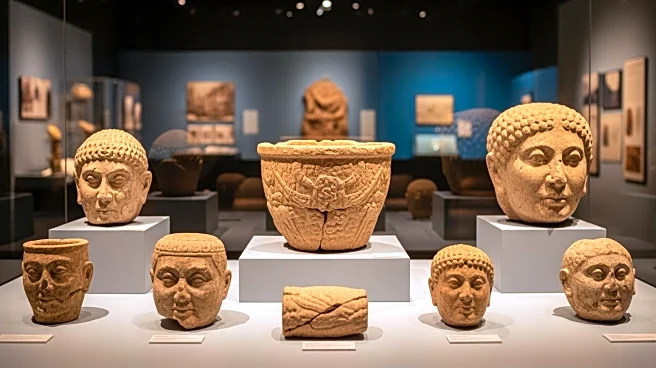What's Happening?
Treasure finds in England have reached a record high, with 1,446 discoveries reported in 2024, according to provisional government figures recorded by the British Museum's Portable Antiquities Scheme.
This marks an increase from 1,266 finds the previous year. The finds include a variety of artefacts, such as a Viking king's coin and a Roman lamp shaped like a human foot. The definition of treasure was expanded in July 2023 to include objects at least 200 years old and of significant historical, archaeological, or cultural importance, regardless of the metal used. Eastern England, particularly Norfolk, has been a hotspot for these discoveries, with 138 finds in 2024. The increase in treasure finds is attributed to more detectorists, better reporting practices, and agricultural activities that disturb archaeological sites.
Why It's Important?
The surge in treasure finds in England is significant for historical and archaeological research, as it provides new insights into the country's past. The expanded definition of treasure allows for a broader range of artefacts to be considered, enriching the understanding of historical periods such as the Viking era and Roman Britain. This development also highlights the role of metal detectorists in uncovering and preserving historical artefacts, contributing to the collective knowledge of England's heritage. The findings can influence public policy regarding heritage conservation and land use, as discussions about preserving historical sites become more pertinent.
What's Next?
The provisional figures for 2024 will be confirmed in 2026, which will include a detailed count of individual artefacts. This confirmation will likely lead to further analysis and potentially more discoveries as the expanded definition of treasure encourages more reporting. The ongoing collaboration between detectorists and archaeologists may lead to improved methods for preserving and studying artefacts. Additionally, discussions with landowners and policymakers about the impact of agricultural practices on archaeological sites are expected to continue, potentially leading to new regulations or incentives for conservation.
Beyond the Headlines
The record number of treasure finds raises ethical questions about the ownership and commercialization of historical artefacts. As more items are discovered, the debate over who should have access to these treasures and how they should be displayed or preserved intensifies. The role of private collectors versus public institutions in maintaining these artefacts could become a contentious issue, influencing cultural policies and museum practices.












